- "Orcs again multiply in secret and occupy many deep places (especially those anciently made by the Dwarves) in the Misty Mountains. They do this so stealthily that none are aware of it, until they have great forces hidden and are ready to bar all the passes from Eriador into Anduin's vales, according to the plan of their master in Dol Guldur."
- —The Peoples of Middle-earth, "The Tale of Years of the Third Age"
The Northern Orcs,[2] also known as the Orcs of the Misty Mountains or the Northerners, were collections of Orc-tribes that lived deep throughout the Misty Mountains following the First Age's War of Wrath, hence serving Sauron the Dark Lord or his agents in wars of the Second and Third Ages.
History
Origin
- "In the final destruction of Thangorodrim and the casting out of Morgoth, their begetter, those in his immediate service had been destroyed, though no doubt some escaped and fled east into hiding."
- —The Nature of Middle-earth, "Silvan Elves and Silvan Elvish"
Following the War of Wrath and Morgoth's ousting at the end of the First Age most of the Orcs from Thangorodrim were destroyed, but others escaped and remained scattered throughout northern Middle-earth.[3] Leaderless without a Dark Lord, the Orcs set up their own petty realms, feuding amongst each other and growing accustomed to independence.[4] In their flight eastwards, the Northern Orcs trespassed on the lands of Dwarves and Northmen, but were successfully repelled by the Alliance of Dwarves and Men.[5]
Second Age
- "But in the Second Age Sauron, when he turned back to evil, had gathered into his service all the Orks that were scattered far and wide in the Northern world, cowed and masterless, furtive lurkers in dark places. He rekindled the lusts of their black hearts; and to some he showed favour and fed them lavishly, and training them into tribes of strong and cruel warriors."
- —The Nature of Middle-earth, "Silvan Elves and Silvan Elvish"
Arising as Morgoth's successor in the Second Age, Sauron gathered all the Northern Orcs into his service, showing some favor and turning the scattered tribes into strong hordes[3][6] which were "commanded by grim servants of Barad-dûr".[7] As the Dark Lord moved into Eriador in the War of the Elves and Sauron, a group of Northern Orcs led by his agents overran the mountains. Not long after Eregion fell in SA 1697, they seized the Dwarven stronghold of Gundabad, allowing them to infest the Ered Mithrin, blocking all communications between Khazad-dûm and the Iron Hills.[5]
During the War of the Last Alliance, Sauron sent many Mordor-orcs to reinforce the Orcs of the Misty Mountains in an attempt to slow the advance of his chief adversaries, Gil-galad and Elendil; the Dark Lord's hordes, however, cowered from the Last Alliance and hid themselves along the Anduin as well as in what would become Mirkwood. Cut off from Sauron's main host, they would remain unaware of their master's defeat and probably believed that he had won.[7]
Third Age
Steady resurgence
- "The Orcs of the Mountains were stiffened and commanded by grim servants of Barad-dûr, sent out long before to watch the passes, and though it was unknown to them the Ring, cut from his black hand two years before, was still laden with Sauron's evil will and called to all his servants for their aid."
- —Unfinished Tales of Númenor and Middle-earth, "The Disaster of the Gladden Fields"
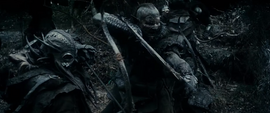
Orcs of the Mountains about to shoot Isildur in the Anduin, as seen in The Lord of the Rings: The Fellowship of the Ring
In the early Third Age, the Orcs of the Misty Mountains - led by Orc-chiefs from Barad-dûr - ambushed Isildur and his escort at the Gladden Fields. In the ensuing battle, they slew the High-king of Gondor and Arnor and his guards.[7]
With Mount Gundabad as their capital,[8] the Northern Orcs had established Orc-holds throughout the mountains in places like the High Pass and Mount Gram.[9][10] Stirred by Sauron's steady re-emergence, the Orcs of the Misty Mountains began to multiply and harass the Dwarves by TA 1300.[11] Around the same time, the Dark Lord's captain, the Witch-king, called some of the Northern Orcs to Angmar to serve under his banner and crush Isildur's Heirs in Arnor. Though the Lord of the Nazgûl was ultimately defeated and Angmar fell, Gundabad continued to be held by Orcs.
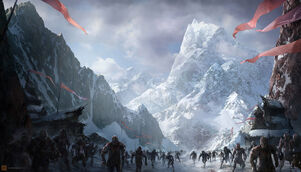
Northern Orcs gathering at Gundabad; concept piece from The Lord of the Rings: War in the North
After the Longbeards were driven from Khazad-dûm by Durin's Bane in TA 1981, some Northern Orcs occupied the stronghold; these Moria-orcs lived in an uneasy truce with the Balrog.[12] Around TA 2480, Sauron began "to people Moria with his creatures".[11] Bidden by the Dark Lord, the Northern Orcs started blocking the mountain passes into Eriador,[11] while occupying many of the Dwarves' old mansions.[13] In the year 2509, Celebrían, the wife of Elrond, was waylaid by Northern Orcs in the Redhorn Pass on a journey to Lothlórien. During her captivity, she received a poisoned wound and was tormented until her late rescue by her sons, Elladan and Elrohir. In the spring of the year 2510, the Orcs of the Misty Mountains, in league with the Balchoth Easterlings, overran Gondor's province Calenardhon. With the much-needed aid of the Éothéod, the Gondorians repelled Sauron's minions.[11] Nonetheless, by 2740, the Northern Orcs continued to grow bolder in their incursions: the Orcs of Mount Gram led by their king, Golfimbul, invaded Eriador and fought many skirmishes against the Rangers of the North. In TA 2747, one group reached the Shire only to be defeated by the Shire-folk in the Battle of the Green Fields when Golfimbul himself was beheaded by Bandobras Took.[9] By the following year, the last Orc-holds of the retreating Orcs had been rooted out.[14]
Conflicts with the Dwarves
- "Ever since the fall of the Great Goblin of the Misty Mountains the hatred of their race for the dwarves had been rekindled to fury. Messengers had passed to and fro between all their cities, colonies and strongholds; for they resolved now to win the dominion of the North. Tidings they had gathered in secret ways; and in all the mountains there was a forging and an arming. Then they marched and gathered by hill and valley, going ever by tunnel or under dark, until around and beneath the great mountain Gundabad of the North, where was their capital, a vast host was assembled ready to sweep down in time of storm unawares upon the South."
- —The Hobbit, "The Clouds Burst"
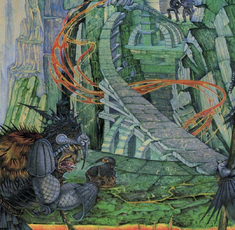
A hostile Orc in Moria during the late Third Age, by Roger Garland
By TA 2790, most of the Orcs of the Misty Mountains, chiefly the Moria-orcs, were ruled by Azog, the self-styled chieftain of Moria. The slaying of Thrór, King of Durin's Folk, by Azog resulted in the War of the Dwarves and Orcs, in which the Longbeards sacked many strongholds of the Northern Orcs, including Gundabad, until the Battle of Azanulbizar that occurred outside the western entrance to Moria. There, the Orcs were defeated and Azog was beheaded by Dáin II.[15] Many of the Northern Orcs crept back to their caverns or fled southwards through Rohan into the White Mountains, building many Orc-holds and harassing the neighboring Rohirrim for two generations.[16] - even slaying King Walda - until they were purged by King Folca.[16] However, the Orcs of the Misty Mountains continued to hold Moria despite the Dwarves' victory, and also retook Gundabad in the north, while Bolg claimed the seat of his late sire, Azog.[8]
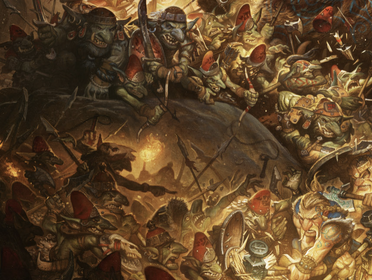
Orcs of the Misty Mountains in the Battle of Five Armies, depicted by Justin Gerard
By TA 2941, the Orcs of Goblin-town, led by the Great Goblin, forged an alliance with Wargs against the nearby Woodmen, seeking to destroy or enslave them.[17] During the Quest of Erebor, the Northern Orcs captured Thorin and Company and held them prisoner, believing them to be spies of their enemies. Thorin II and his companions were rescued by Gandalf the Grey, who felled the Great Goblin himself, and led them out of the tunnels. Bitter at their chieftain's slaying by the Wizard,[10] the Northern Orcs banded with the Wargs in pursuing the company, but were prevented from exacting retribution due to the intervention of the Great Eagles.[17] After the death of the Dragon Smaug, Bolg assembled the Northern Orcs of the mountains at Mount Gundabad and marched towards Erebor, seeking revenge and plunder. In the ensuing Battle of Five Armies, Bolg of the North was slain by Beorn the skin-changer and the Orc army was vanquished by the combined forces of Elves, Men, Dwarves and Great Eagles.[8][18]
War of the Ring
- "At that time Sauron had arisen again, and the shadow of Mordor reached out to Rohan. Orcs began to raid in the eastern regions and slay or steal horses. Others also came down from the Misty Mountains, many being great Uruks in the service of Saruman, though it was long before that was suspected."
- —The Lord of the Rings, "The House of Eorl"
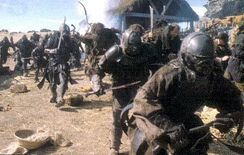
Orcs originally of the Misty Mountains raiding Rohan, as seen in The Lord of the Rings: The Two Towers
With their enemies' number dwindling,[18] the late Thorin's companion, Balin, led an expedition to reclaim Khazad-dûm, but this effort was was at first cut short by the Orcs of the Misty Mountains, who eventually slaughtered them all. As the war drew near, the Northern Orcs were joined by some Uruks of Mordor.[12] Saruman the White, Sauron's vassal, recruited a group of Northern Orcs to dwell in Isengard to be part of his army to overrun the Rohirrim; though he may also have used these Orcs in experiments which resulted in the creation of the Isengarders.[16] With their aid, Saruman turned Isengard into "a child's model or a slave's flattery" of Mordor.[19] Coinciding with eastern raids by Mordor-orcs, Northern Orcs with some Uruk-hai raided Rohan. Although they were pushed back, the First Marshal of the Mark, Éomund, was slain in these attacks.[16]
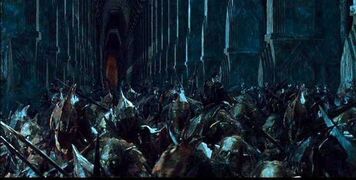
Northern Orcs pursuing the Fellowship in Moria in The Lord of the Rings: The Fellowship of the Ring (2001)
In the Quest of the Ring, the Fellowship was forced to journey through the former Khazad-dûm and was pursued by Moria-orcs and Cave-trolls, even being cornered in the Chamber of Mazarbul until escaping the mines.[12] Still following the company, the Orcs of the Misty Mountains made a sortie into the Northern Fences of Lothlórien, but were defeated by the Galadhrim.[20] Some Northerners, together with Saruman's scouts and some Mordor-orcs, ambushed the Fellowship at Amon Hen, mortally-wounding Boromir of Gondor and capturing the Hobbits Merry and Pippin (wrongfully assuming one to be the Ring-bearer). Disputes owing to Saruman's duplicity towards Sauron slowed the troop down and all of the Orcs were ultimately slain to the last by Rohirrim on Fangorn Forest's eaves.[21] As the War of the Ring unfurled, Saruman renewed efforts against Théoden of Rohan, sending Northern Orcs alongside Isengarders and Dunlendings to ravage the Westfold, as well as to slay the royal heir, Théodred, at the Fords of Isen. The corrupted Wizard sent his 10,000 strong army to crush the King at Helm's Deep and so deliver Rohan to his "dark master".[22][23] The Battle of the Hornburg and the Last march of the Ents resulted in the vanquishment of the Isengarders and Sauron's loss of his puppet Saruman.[22][24] The Northern Orcs were presumably the core of the forces raised by Sauron's lieutenant, Khamûl, second of the Nazgûl, to attack both the Woodland Realm and Lothlórien from Dol Guldur in Mirkwood and were beaten upon the fortress' destruction by Lady Galadriel.[25]
Legacy
- "It is not unlikely that they invented some of the machines that have since troubled the world, especially the ingenious devices for killing large numbers of people at once, for wheels and engines and explosives always delighted them."
- —The Hobbit, "Over Hill and Under Hill"
With the final downfall of Sauron,[26] and that of his chief agents,[27][28] the Northern Orcs were diminished, allowing the Longbeards under their king, Durin VII, to reclaim Khazad-dûm in the Fourth Age.[5] Some war machines that "troubled the world" well into following Ages were likely devised by the Orcs of the Misty Mountains.[10]
In adaptations
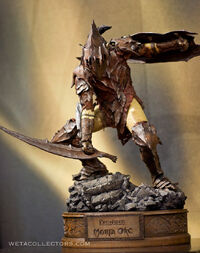
A heavily armed Goblin warrior as conceived for The Lord of the Rings films
In popular parlance, perhaps because the word goblins was used in The Hobbit whereas those directly called Orcs came across as more fearsome in Tolkien's other works, it has become common for the Orcs of the Misty Mountains to be known as goblins to be distinguished from the common Orc as smaller, less fearsome, and less socially evolved. This idea has gained currency through its widespread adoption in various adaptations of Tolkien's stories, as well as in many derivative fantasy worlds, including novels, movies, and games such as Dungeons & Dragons.
The Hobbit (1977 film)
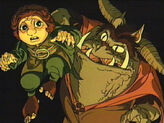
The strange beast-like Goblins from the 1977 film
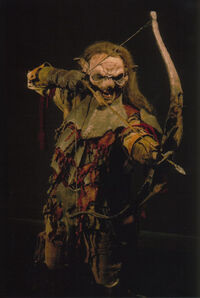
An archer of Moria, rendered for The Lord of the Rings films
The animated Northern Orcs (here called "Goblins") appearing in this film are large, putrid green, bestial creatures. They are far bulkier than what one normally expects for a Goblin, being either hugely muscular or fat. They also had bulbous toad-like heads featuring tusks, lupine ears, canine-like noses, and even horns.
The Lord of the Rings film trilogy
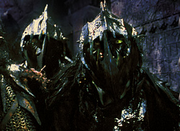
Goblins of Moria in the films
In Peter Jackson's film The Fellowship of the Ring (2001), the Orcs of the Misty Mountains have overrun the dwarven colony in Moria long before the events of the movie. When the Fellowship passes through the abandoned Dwarf city of Dwarrowdelf, Pippin accidentally alerts the Moria-orcs to their presence, causing a fight to break out in Balin's Tomb. In this instance, their main weapon appears to be a Cave Troll, which has to be brought down by the whole Fellowship, but the entire force is wiped out by the end of the battle.
However, the skirmish allows a much larger force of Moria-orcs to close in on the Fellowship, who flee to the Bridge of Khazad-dûm. Unfortunately for them, even more Goblins intercept them in one of Dwarrowdelf's great halls, emerging from cracks in the floor and holes in the ceiling to aid their comrades. Trapped in a sea of Orcs, the Fellowship could only prepare for death, but the evil creatures suddenly paused as a menacing roar echoed in the distance. As a distant hall lit with a fiery orange glow, the Orcs inexplicably fled in all directions, leaving the Fellowship to wonder at their fortune — as well as at what was coming next: Durin's Bane.
In the book, the Northern Orcs are more effective fighters than in the film adaptation. It was an Orc chieftain who stabbed Frodo in the original story, rather than the Cave Troll shown in the movie, and Sam was also injured by another Orc. Haldir tells the Fellowship that Orcs will pursue enemies for long distances, even during the day, to avenge the death of a chieftain.
The Hobbit: An Unexpected Journey
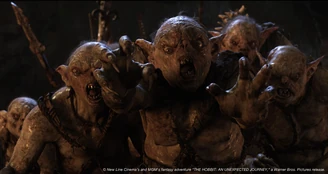
Goblins of the High Pass
The Moria-orcs seen in the film seem to be larger and bulkier, towering over dwarves but smaller than men. The Orcs (Goblins) of the High Pass seen in Peter Jackson's first installment of the Hobbit trilogy are quite different compared to the Orcs of Moria, having flesh-toned skin and riddled with various skin diseases and deformations like harelips, mismatched or skewed eyes, and crooked-growing fingernails. They are overall much more grotesque than the Northern Orcs seen in the Lord of the Rings trilogy, being as tall as any Dwarf or Hobbit or some reaching to almost human height.
The Hobbit: The Desolation of Smaug
In extended edition of the second film, the Necromancer is revealed by Beorn to be in alliance with the Northern Orcs who had infested Moria, as Azog the Defiler is seen paying homage to the dark figure, and his soldiers gather in Dol Guldur where the Necromancer hides. The Northern Orcs who followed him to Dol Guldur are referred to as Guldur Orcs. They begin to forge weapons and armor in preparation for their master's war in the east region of Rhovanion. After Gandalf was imprisoned by Sauron, the assembled force of Orcs set off towards Erebor to wage war on the unsuspecting Dwarves, Elves, and Men currently there. The host of Guldur Orcs brought along with them terrible creatures of war. Among these creatures were huge and monstrous War Trolls as well as flesh starved Wargs.
The Hobbit: The Battle of the Five Armies
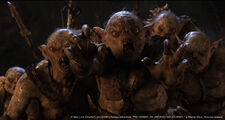
Goblin mercenaries before the Battle of Five Armies
In the third film, Azog's host of 30,000 Guldur Orcs clash with the allied forces in the valley of Erebor and the streets of the ruined city of Dale. During the day long Battle of the Five Armies, thousands were slaughtered at the hands of these orcs, the battle only being won when Thorin Oakenshield killed Azog at the precipice of Ravenhill, thus cutting off the commanding head of the Orc army. The Orc army was thus defeated, and lost a considerable amount of their forces; only a small number managed to escape the battle. Also in the battle, as many as 200-450 Goblins from Goblin-town appeared as goblin mercenaries, joining the forces of Gundabad and Misty Mountains in order to avenge the Great Goblin's death and to get their hands on the reward for aiding the Dark Lord Sauron. Thus, they joined Azog's army adorned in armor to lay siege on the Lonely Mountain. During the Battle of Five Armies, several dozen of them activated catapults mounted on the backs of several War Trolls (who possibly came from somewhere near these orcs) to destroy the walls of Dale, while more than a hundred others storm into the city with the Guldur Orcs, Guldur Olog-hai, and Ogres. Another group of about a hundred goblin mercenaries arrived first at Ravenhill to attack.
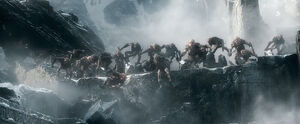
Goblin mercenaries arriving at Ravenhill
Thorin II and Dwalin while Fíli and Kíli entered the caves of Ravenhill to search for Azog. The goblin mercenaries were easily defeated by Thorin and Dwalin. The last remnants of the goblin mercenary band was killed by the Great Eagles, led by Gwaihir the Windlord.
Description
In Peter Jackson's films, being of the same stature as dwarves and hobbits, the Orcs of the Misty Mountains are depicted in appearing to lead a much more tribal life compared to the Orcs of Mordor, often having a chief among smaller groups. Compared to average Orcs, they are less organized and use a vast range of scavenged items of clothing, armour and weaponry. They also have a fear of light and the sun and will not step out in daylight most of the time.
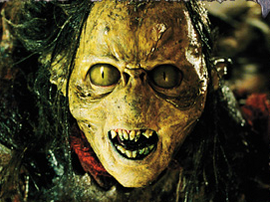
A Moria Goblin in The Lord of the Rings: The Fellowship of the Ring.
There are two varieties of Northern Orcs: the Goblins of the High Pass and the Orcs of Moria. The former have flesh-colored skin and seem to be afflicted with various skin diseases and deformations that include harelips and stunted growth. The Moria-orcs have a very green-colored skin tone compared to their High Pass kinsmen with larger pointier ears and huge bulbous eyes that reflect their nature as cave creatures.

The most dangerous of these two varieties united in Dol Guldur, becoming "Guldur Orcs". Much like Azog himself, these Orcs were more disciplined and dangerous. They were tall, long-limbed, brutal, and bloodthirsty. The Guldur Orcs were heavier-built and larger than the Orcs that took over Erebor during the War of the Ring, though their armor and weapons are similar. Most were hive-minded brutes that worked by the exact orders of the one currently in charge of their forces. When their commanding officer is killed, they would completely lose all methods of strategy and organization.
|
Races of Arda
Ainur | Dwarves | Elves | Ents | Great Eagles | Hobbits | Huorns | Men | Petty-dwarves | Skin-changers (Beornings) Servants of the Shadow:
Barrow-wights | Ettens | Dragons (Fire-drakes and Cold-drakes) | Ogres | Orcs | Spiders | Trolls | Úmaiar | Úvanimor | Vampires | Wargs | Werewolves |
References
- ↑ The Chronology of The Lord of the Rings, pg. 44
- ↑ The Lord of the Rings, vol: II: The Two Towers, chapter I: "The Departure of Boromir"
- ↑ 3.0 3.1 The Nature of Middle-earth, Part Three: The World, its lands and its inhabitants, XVII: "Silvan Elves and Silvan Elvish"
- ↑ Morgoth's Ring, Part Five: Myths Transformed, X
- ↑ 5.0 5.1 5.2 The Peoples of Middle-earth, Part Two: Late Writings, "Of Dwarves and Men"
- ↑ The Nature of Middle-earth, Part Three: The World, its lands and its inhabitants, XVIII: "Note on the Delay of Gil-galad and the Númenóreans"
- ↑ 7.0 7.1 7.2 Unfinished Tales of Númenor and Middle-earth, Part Three: The Third Age, The Disaster of the Gladden Fields
- ↑ 8.0 8.1 8.2 The Hobbit, "The Clouds Burst"
- ↑ 9.0 9.1 The Hobbit, "An Unexpected Party"
- ↑ 10.0 10.1 10.2 The Hobbit, "Over Hill and Under Hill"
- ↑ 11.0 11.1 11.2 11.3 The Lord of the Rings, Appendix B, "The Third Age"
- ↑ 12.0 12.1 12.2 The Lord of the Rings, The Fellowship of the Ring, "The Bridge of Khazad-dûm"
- ↑ The Peoples of Middle-earth, Part One, Chapter 8: "The Tale of Years of the Third Age"
- ↑ The Lord of the Rings, Appendix A, "The Númenorean Kings", "Eriador, Arnor, and the Heirs of Isildur"
- ↑ The Lord of the Rings, Appendix A, "Durin's Folk"
- ↑ 16.0 16.1 16.2 16.3 The Lord of the Rings, Appendix A, "The House of Eorl", "The Kings of the Mark", Second Line, (entry Brytta)
- ↑ 17.0 17.1 The Hobbit, "Out of the Frying-Pan into the Fire"
- ↑ 18.0 18.1 The Hobbit, "The Return Journey"
- ↑ The Lord of the Rings, The Two Towers, "The Road to Isengard"
- ↑ The Lord of the Rings, The Fellowship of the Ring, "Lothlórien"
- ↑ The Lord of the Rings, The Two Towers, "The Uruk-hai"
- ↑ 22.0 22.1 The Lord of the Rings, The Two Towers, "Helm's Deep"
- ↑ The Lord of the Rings, The Two Towers, "The Voice of Saruman"
- ↑ The Lord of the Rings, The Two Towers, "Flotsam and Jetsam"
- ↑ The Lord of the Rings, Appendix B, "The Great Years"
- ↑ The Lord of the Rings, The Return of the King, "The Field of Cormallen"
- ↑ The Lord of the Rings, The Return of the King, "The Battle of Pelennor Fields"
- ↑ The Lord of the Rings, The Return of the King, "The Scouring of the Shie"




